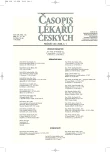Importance of Quantitative Evaluation of BCR-ABL Transcripts Using Real-time PCR for Effective Treatment of Chronic Myeloid Leukemia
Význam kvantitativního hodnocení transkriptů BCR-ABL pomocí real-time PCR pro efektivní léčbu chronické myeloidní leukémie
Východisko.
Molekulárně biologické metody založené na reverzní transkripci a následné polymerázové řetězové reakci (RT-PCR) jsou schopny detekovat přítomnost transkriptu BCR-ABL u chronické myeloidní leukémie (CML). V tomto sdělení prezentujeme naše zkušenosti se sledováním reziduální leukémie metodou real-time PCR s detekcí hybridizačními sondami u nemocných s CML léčených imatinibem a při sběru periferních krvetvorných buněk (PKB).
Metody a výsledky.
Stanovení hladin transkriptu BCR-ABL v periferní krvi bylo provedeno u 27 osob před nasazením a v průběhu léčby imatinibem mesylátem. Medián relativního množství BCR-ABL v periferní krvi před nasazením imatinibu byl 2,55 %. Množství transkriptu u 23 osob bez rezistence vůči imatinibu pokleslo během prvních šesti měsíců léčby na hodnotu 0,02 %. Po dvanáctiměsíční léčbě poklesl medián množství transkriptu na 0,005 %. V dalším průběhu léčby hladiny BCR-ABL kolísaly mezi hodnotami pod detekčním limitem metody (0,001 %) a 0,005 %. Tři pacienti byli vůči imatinibu primárně rezistentní s rozsahem hodnot od 0,13 % do 11,7 %. Jeden pacient vykazoval po 18 měsících léčby známky molekulárního relapsu. Z 16 pacientů po stimulaci PKB filgrastimem měly pouze dvě vyšetřované osoby hodnoty BCR-ABL v periferní krvi i v PKB pod detekčním limitem použité metody. U ostatních osob se koncentrace fúzního transkriptu pohybovala v koncentracích spolehlivě stanovitelných metodou RT-PCR.
Závěry.
Vzhledem k svému prognostickému významu je vyšetření BCR-ABL vhodné pro monitorování kinetiky reziduální choroby. Stanovení provedené v koncentrátu PKB jako potenciálním autotransplantátu může kompletovat informace o kvalitě těchto buněk z hlediska proporce BCR-ABL transkriptu a nastínit další možné terapeutické postupy a prognózu pacienta.
Klíčová slova:
BCR-ABL, RT-PCR, imatinib, minimální reziduální choroba, leukémie.
Authors:
M. Beránek; J. Voglová 1; A. Sýkorová 1; D. Belada 1; M. Bláha 1
Authors‘ workplace:
Ústav klinické biochemie a diagnostiky LF UK a FN, Hradec Králové
; II. interní klinika, oddělení klinické hematologie LF a FN, Hradec Králové
1
Published in:
Čas. Lék. čes. 2006; 145: 25-29
Category:
Original Article
Overview
Background.
Molecular biology methods based on reverse transcription and polymerase chain reaction (RT-PCR) are able to detect the presence of BCR-ABL transcripts in chronic myeloid leukemia (CML). In this study we present our experience with monitoring of residual disease using real-time PCR with hybridization probes detection in patients treated with imatinib mesylate and in collected peripheral blood progenitor cells (PBPC).
Methods and Results.
We measured the level of BCR-ABL transcripts in peripheral blood cells of 27 subjects before and in the course of the imatinib treatment. The median of relative quantity of BCR-ABL in the blood before imatinib therapy was 2.55%. The number of the transcripts in 23 imatinib-sensitive subjects decreased to 0.02% in 6 months. After 12 months of the treatment the BCR-ABL median was 0.005%. Subsequent levels fluctuated between values below the detection limit (DL, 0.001%) and 0.005%. Three patients were primarily resistant to imatinib with the BCR-ABL range of 0.13%-11,7% during the treatment. One subject showed marks of molecular relapse after 18 months of the treatment. Only two of 16 filgrastim-stimulated patients had BCR-ABL levels in the blood and in collected PBPC below DL. In other subjects BCR-ABL transcripts were determined within the measurable range of RT-PCR.
Conclusions.
Taking into account prognostic importance, the measurement of BCR-ABL transcripts is an effective approach to monitoring of residual CML kinetics. Evaluation of BCR-ABL levels in collected PBPC can complete information on quality of the cells in potential autotransplants, and choose subsequent therapeutic protocols and patient prognosis.
Key words:
BCR-ABL, RT-PCR, imatinib, minimal residual disease, leukemia.
Labels
Addictology Allergology and clinical immunology Angiology Audiology Clinical biochemistry Dermatology & STDs Paediatric gastroenterology Paediatric surgery Paediatric cardiology Paediatric neurology Paediatric ENT Paediatric psychiatry Paediatric rheumatology Diabetology Pharmacy Vascular surgery Pain management Dental HygienistArticle was published in
Journal of Czech Physicians

- Metamizole at a Glance and in Practice – Effective Non-Opioid Analgesic for All Ages
- Advances in the Treatment of Myasthenia Gravis on the Horizon
- Possibilities of Using Metamizole in the Treatment of Acute Primary Headaches
- Metamizole in perioperative treatment in children under 14 years – results of a questionnaire survey from practice
- Obstacle Called Vasospasm: Which Solution Is Most Effective in Microsurgery and How to Pharmacologically Assist It?
Most read in this issue
- Impact Factor – Good Servant, but a Bad Master
- Acute Toxicity of High Dose Interstitial Brachytherapy Boost in Prostate Cancer
- Abuse of Buprenorphine Becomes a Problem of the Czech Republic
- Principle and Importance of Using the Array CGH in Hematooncology
